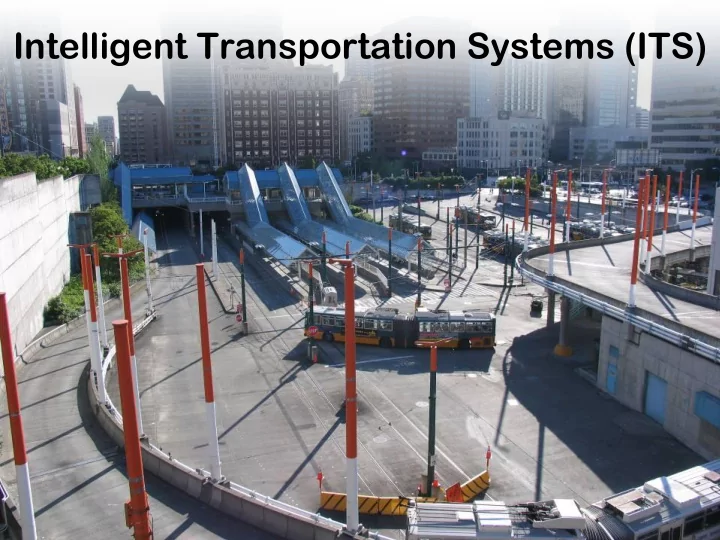

Intelligent Transportation Systems (ITS)
Outline • Need for traffic solutions • Possible solutions • Intelligent Transportation Systems
Road Use Growth 4.00 Increase Multiple (Based on 1960 Values) 3.50 Vehicle Miles Traveled 3.00 Registered Vehicles Statute Miles of Roadway 2.50 2.00 1.50 1.00 1960 1965 1970 1975 1980 1985 1990 1995 2000 2005 Year From the Bureau of Transportation Statistics, National Transportation Statistics 2003
Changes in Congested Peak-Period Travel Change in Congested Peak-Period Travel (1982-2000) 100 Percent of Peak-Period Travel in Los Angeles, CA 90 80 Seattle-Everett, WA Congestion 70 Boston, MA 60 50 Denver, CO 40 New York, NY- 30 Northeastern, NJ 20 1982 1990 1994 2000 Year
Problems Caused by Congestion • Increased… – Travel time – Travel cost – Air pollution – Accident risk
Options • Construct new roads – Covered in geometric design – Not likely to happen on a large scale • Reduce Traffic – Travel demand management – Alternative transportation • Increase existing infrastructure capacity – Uses intelligent transportation systems (ITS)
Construction Is Part of the Solution
Option 1: Construction Highway Construction Cost Sampling Cost per Project Total Cost Lane-Miles Lane-Mile Route 3, North Boston $395.0 million 42 $9.4 million I-4 Tampa to Orlando $403.0 million 73 $5.5 million I-5 Oregon $30.0 million 5.16 $5.8 million US 26 Sunset Hwy. Oregon $10.6 million 2.24 $4.8 million US 12 near Walla Walla River $36.4 million 25 $1.5 million US 101 on Olympic Peninsula $1.8 million 0.8 $2.2 million General Conclusion Highways cost $1 to $10 million per lane-mile to build
San Francisco’s Embarcadero Freeway: Removed 1991
Option 2: Alternative Transport But significant new rail capacity will face the same hurdles as new highway capacity.
Option 2: Alternative Transport SkyTran: Personal MagLev Transporter
Option 3: Increase Existing Infrastructure Capacity • An alternative to expensive new highway construction is the implementation of strategies that promote more efficient utilization of transportation infrastructures. • These strategies are known as the Intelligent Transportation Systems (ITS), which aims to reduce travel time, ease delay and congestion, improve safety, and reduce pollutant emissions
How Much Capacity Is There? Full Capacity Highway Capacity
How Much Capacity Is There? Remaining Effective Capacity Highway Capacity Incidents can comprise 50% of peak period congestion. 1 min delay in clearance = 4 to 5 min of traffic backup. Incidents: more delay is caused by incidents than by recurring peak period congestion.
How Much Capacity Is There? Remaining Effective Capacity Highway Capacity Caltrans reports 20% of freeway centerline miles are under construction. Work zones: major cost is delay imparted to the traveler Incidents: more delay is caused by incidents than by recurring peak period congestion.
How Much Capacity Is There? Remaining Effective Capacity Highway Capacity 75% of NHS is subject to snow & 100% is subject to rain. Weather: Snow, fog, rain can all restrict capacity Work zones: major cost is delay imparted to the traveler Incidents: more delay is caused by incidents than by recurring peak period congestion.
How Much Capacity Is There? Remaining Effective Capacity Periodic events can cause further restrict capacity. Highway Capacity Special events and disasters further restrict capacity Weather: Snow, fog, rain can all restrict capacity Work zones: major cost is delay imparted to the traveler Incidents: more delay is caused by incidents than by recurring peak period congestion.
How Much Capacity Is There? Remaining Effective Capacity Highway Capacity Special events and disasters further restrict capacity Weather: Snow, fog, rain can all restrict capacity Work zones: major cost is delay imparted to the traveler Incidents: more delay is caused by incidents than by recurring peak period congestion.
How Much Capacity Is There? ITS Remaining Effective Capacity Highway Capacity
Five Primary Functional Areas of ITS • Advanced Traffic Management Systems (ATMS) • Advanced Traveler Information Systems (ATIS) • Commercial Vehicle Operations (CVO) • Advanced Public Transportation Systems (APTS) • Advanced Vehicle Control Systems (AVCS)
Advanced Traffic Management Systems Photo from the Human-Computer Interaction Lab: University of Maryland
WSDOT Traffic Systems Management Center
WSDOT Traffic Systems Management Center
WSDOT Traffic Systems Management Center
ATMS: Snoqualmie Pass
Advanced Traveler Information Systems
ATIS: trafficgauge
WAP Traffic www.wiresoft.net/traffic/seattle
ATIS: Traffic Cameras
Commercial Vehicle Operations • Apply, pay for and receive permits, registrations, and licenses electronically • Share of common trucking data across agencies • Exchange information electronically with roadside enforcement personnel • Electronic “screening” of trucks for safety or other regulatory violations • Share information across state lines and with Federal information systems
CVO: Weigh-In-Motion System
Advanced Public Transportation Systems
An Example of APTS http://busview.its.washington.edu/busview_launch.jsp?maps=gif
Seattle Bus Monster http://www.busmonster.com
APTS: Bus Signal Priority
Advanced Vehicle Control Systems Intelligent Cruise Control (ICC) System
Recommend
More recommend